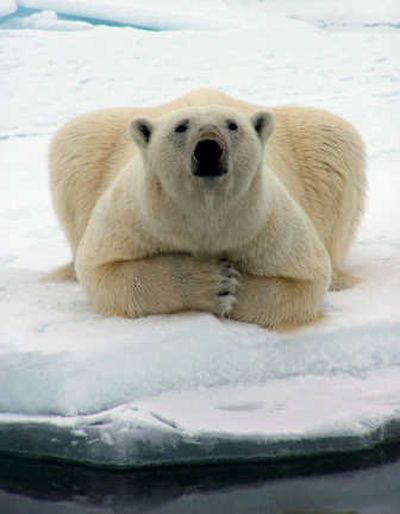Bear’s threatened listing heralds legal battles

The Interior Department on Wednesday designated the polar bear as threatened with extinction because of shrinking sea ice, making it the first creature added to the Endangered Species List primarily because of global warming.
The designation under the Endangered Species Act requires the agency to identify critical habitat to be protected and to form a strategy to assist the bear population’s recovery.
But the department also issued special rules designed to exempt from the law offshore oil and gas drilling in prime polar bear habitat off Alaska’s north coast.
Moreover, Interior Secretary Dirk Kempthorne announced he was taking steps to short-circuit legal plans by conservation groups to use the polar bear’s protected status to block new power plants and other sources of carbon dioxide and other gases that contribute to global warming.
“Listing the polar bear as threatened,” he said, “… should not open the door to use the ESA to regulate greenhouse gas emissions from automobiles, power plants and other sources. That would be a wholly inappropriate use of the Endangered Species Act. The ESA is not the right tool to set U.S. climate policy.”
Dale Hall, director of the Interior Department’s Fish and Wildlife Service, said the law was designed to focus on preserving species and their habitat from localized threats such as filling wetlands, felling trees and development. He cast doubt on whether far-flung activities, such as emissions from tailpipes, feedlots and smokestacks around the globe, could be directly linked to the shrinking sea ice.
“We have to connect the dots between an action and an impact on a species,” Hall said. “We don’t have the science to do that.”
Conservation groups, however, have been gearing up to test that premise in court.
Kassie Siegel, an attorney with the Center for Biological Diversity, said efforts to limit the reach of the designation and avoid clamping down on greenhouse gas emissions “are illegal and won’t hold up in court.”
A Supreme Court ruling last year that defined carbon dioxide as a pollutant undermines the Interior Department’s position, said Andrew Wetzler, an attorney with the Natural Resources Defense Council. Under Massachusetts v. EPA, he said, “You don’t need to show that you can solve an entire problem by going after a specific source.”
Opponents of the designation likewise plan to challenge Kempthorne’s decision. The Pacific Legal Foundation, a property rights group, vowed to sue, saying the agency relied on speculative computer models about warming arctic and vanishing ice.
In announcing his decision, Kempthorne complained about the “inflexibility” of the Endangered Species Act and said it fails to weigh negative economic impacts on people or industries. But he said he was left with no legal choice.
“You simply must look at the best available science on this species and project it into the future,” Kempthorne said. “I’ve have accepted the science. … This may not be a popular decision, but it’s the right decision.”
It was the first time in more than two years that the Interior Department extended protections to another species under the Endangered Species Act – the longest hiatus of new listings by the department since President Nixon signed the law in 1973.
Last summer, arctic sea ice receded to record levels – a retreat that about half of the climate modelers did not think would happen until 2050.
Polar bears are experts at hunting ringed seals and other prey from sea ice. But they are so unsuccessful on land they spend their summers fasting, losing more than 2 pounds a day.
This forced fast is an average of three weeks longer than it was 30 years ago, according to studies in Canada’s western Hudson Bay. This gives the bears less time to hunt and build up the fat reserves they need to make it until they can resume hunting when ice re-forms in the fall.
A group of Canadian scientists last month declared the polar bear as a “species of concern,” but stopped short of saying it was “threatened” with extinction – a designation that could have restricted hunting by Canada’s Inuit people.